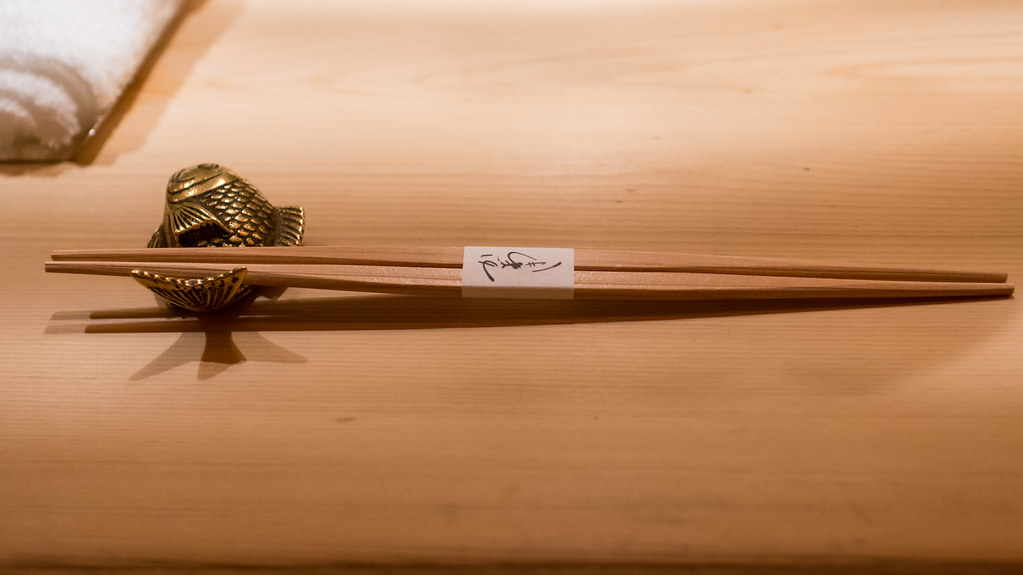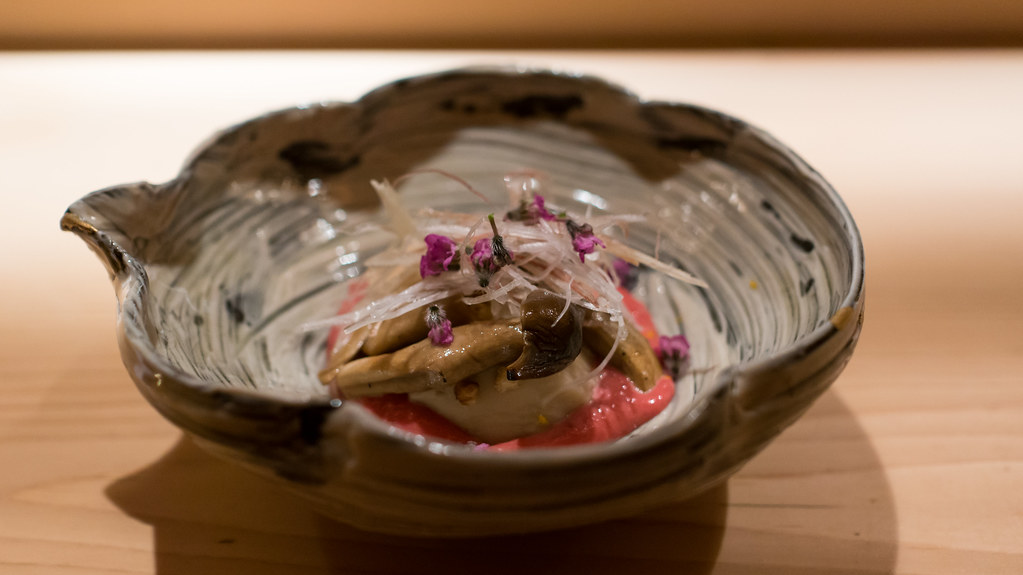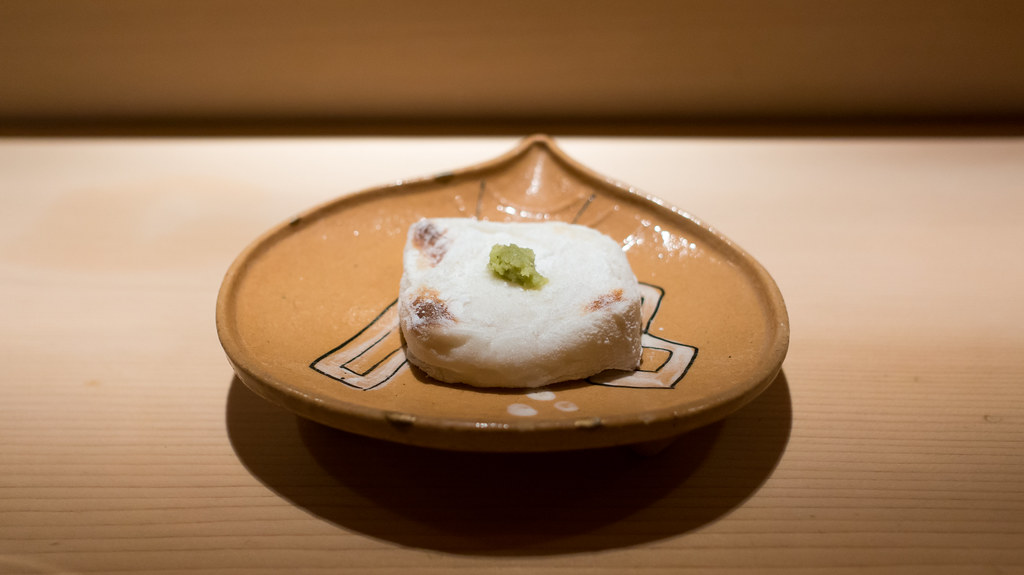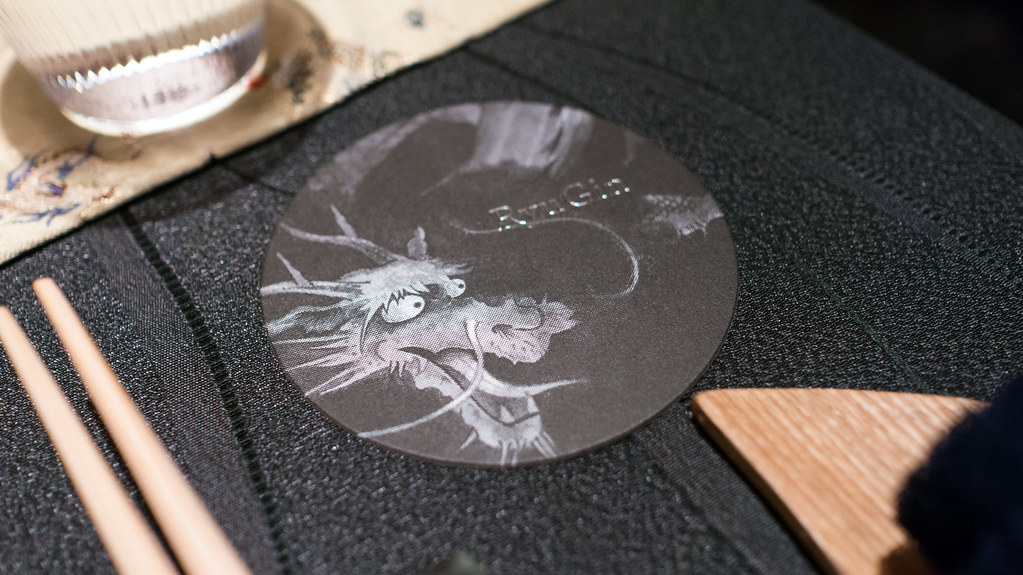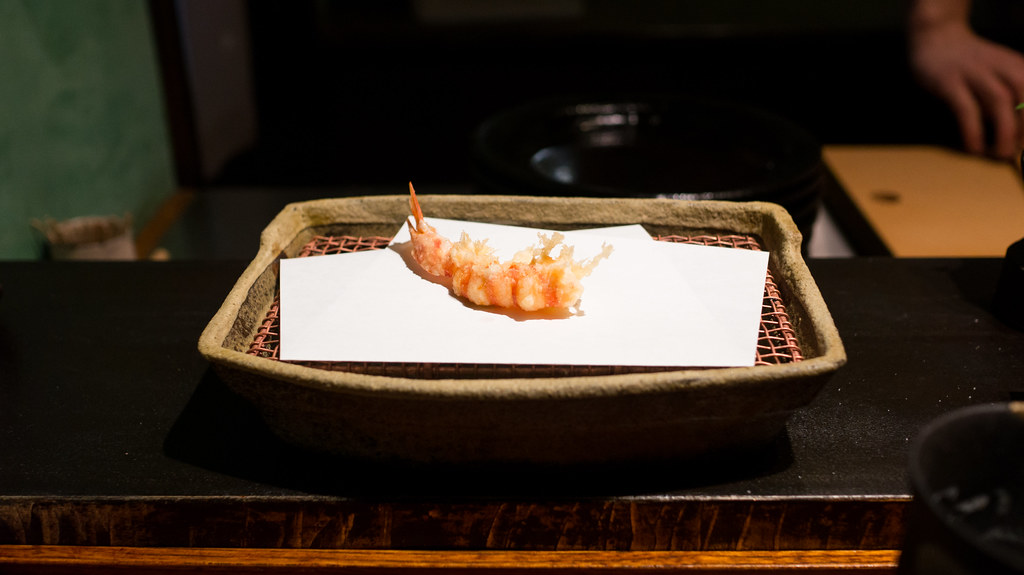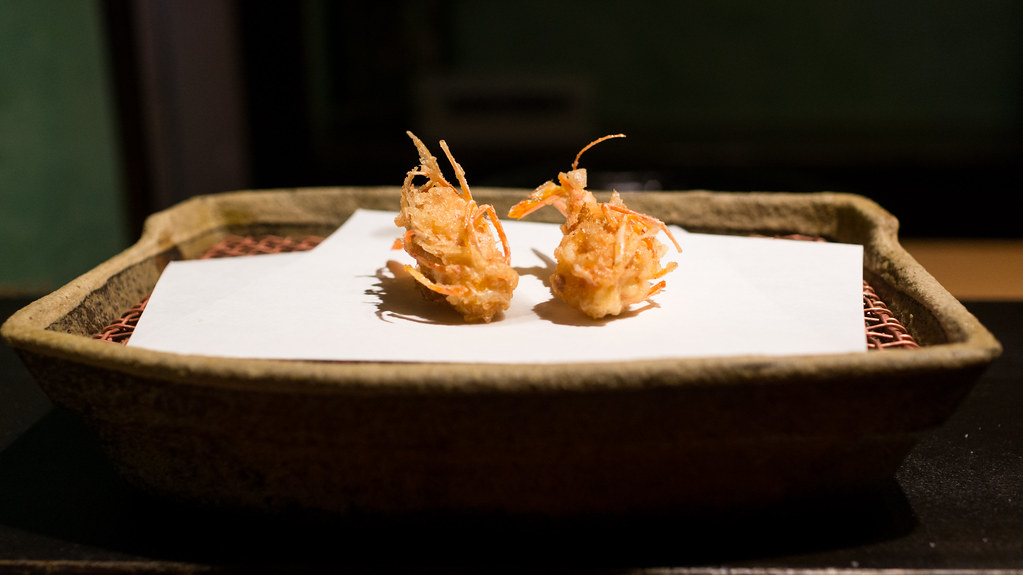Japan would seem to have a massive trade surplus when it comes to culinary inspiration. From the minimalist lightness of French nouvelle cuisine of the 1970's, to America's never-ending if not always quality-driven fixation on sushi, to "fusion" in so many guises, to this past decade's ramen craze, the traffic in ideas appears to be largely outbound. But Japan also absorbs influences too; and when it does so, it's usually with the same intense dedication to craft that pervades virtually all other pursuits there.[1]
Azabu Kadowaki is a resolutely Japanese restaurant; in fact, chef Toshiya Kadowaki was famed for turning down stars when the Michelin guide first came to Japan, on the basis that “Japanese food was created here, and only Japanese know it ... How can a bunch of foreigners show up and tell us what is good or bad?” (He ultimately relented, as the restaurant now has two of those stars that Kadowaki initially shunned.) But it also clearly bears the mark of some Western influences, filtered through a Japanese prism.
If I have my genres right, Kadowaki is a "kappo ryori" restaurant – high end food served straight from the kitchen, usually by the chef himself presenting it across the counter. It is an elegantly appointed space: honed wood counters and cabinets with the precision workmanship of a luxury yacht, cooking instruments all encased in patterned ceramic. There were maybe eight seats at the bar that faced that gorgeous open kitchen, though there appeared to be a couple private rooms as well that servers flitted in and out of.
(You can see all my pictures in this Azabu Kadowaki flickr set.)
The meal is omakase style: other than a diner's selection between snow crab and fugu as a "main" course, and between three different price points (all designated when the reservation is booked), everything else is chef's choice.
Our dinner started with an unusual and beautiful dish: a block of rich, nutty sesame tofu, nestled in a bed of magenta-hued beet miso, crowned with some meaty roasted mushrooms and bright purple flower buds. It defied any stereotype of a tofu-based dish being bland or insubstantial.
Almost simultaneously, we were also served a block of what I believe was either mochi or konnyaku (a/k/a yam cake or devil's tongue jelly). Toasted around the edges, it was chewy, almost elastic in texture, and blandly starchy in flavor other than the dab of freshly grated wasabi. It was texturally intriguing, but I can't say much more about it than that.
The next course was one of my favorites, blending eastern and western components: a cube of winter daikon radish draped with a slice of roasted pear, all enrobed in a creamy cod roe sauce and topped with a fine julienne of fresh black truffle. Cooked daikon is a highly underrated ingredient: tender but still having substance, silky but with a pleasing bite of graininess against the teeth, and a mild sweet flavor. Those qualities were mirrored and amplified by the roasted pear, which brought a more intense caramelized sweetness, the mildly salty, creamy sauce, and the earthy, aromatic truffle. There were no bold flavors here – rather it was all subtlety and grace.
(continued ...)
Showing posts with label Japan. Show all posts
Showing posts with label Japan. Show all posts
Wednesday, May 21, 2014
Friday, April 18, 2014
"here be dragons" | Nihonryori Ryugin - 龍吟 - Tokyo
There are few places I've been as to which opinions diverge as widely as Nihonryori RyuGin, the Tokyo restaurant of Chef Seiji Yamamoto. It holds three Michelin stars and, for whatever it's worth, has recently made a rapid climb up the S. Pellegrino "50 Best Restaurants" list.[1] More important to me, several folks whose opinions I've come to trust had spoken of great meals there.[2] And yet other reports – including more recent visits from some of those same people – ranged from indifferent to disappointed.
I can't speak to anyone's experience but my own. And even then, there are few culinary genres as to which I feel less qualified to opine than kaiseki, which lies at the foundation of RyuGin's style, and which for me was unexplored territory prior to this meal.[3] So take it for whatever it's worth: I found RyuGin to be a beautiful, well-executed and fully realized dining experience.
My admittedly naive understanding of kaiseki includes at least a few components: a strong focus on seasonality; a somewhat regimented procession of courses that feature a variety of cooking methods; and layers of symbolism – in the ingredients, the presentations, and even the plates themselves. As a meal that endeavors to tell a story of the season, this centuries-old tradition has uncanny similarities to what's lately been labeled the "New Nordic" school of cooking.
Though RyuGin has a reputation as being in the thrall of the "modernists," its style seems to have become more, rather than less, traditional over the past few years. Chef Yamamoto is familiar with the latest techniques and gadgetry, but for the most part, they seemed to stay in the kitchen and were virtually invisible on the plate. Rather, the meal unfolded as a meditation on Japanese ingredients, seasons, and flavors.
(You can see all my pictures in this Nihonryori RyuGin flickr set).
The attention to both elegance and craft is on display even before any food arrives, as the server offers a choice of beautiful Edo Kiriko sake cups for each diner to select.[4] Sake is decanted into a cut crystal carafe, nestled in a matching bowl filled with crushed ice. The coaster is emblazoned with a dragon, a motif that makes several appearances around the restaurant.[5]
The menu is wordy. This is a dinner with a "title," "Plating the Prodigality of Japanese Nature," and this first course is described as "Beginning with a variety of Sensations ... Seasonality, Aroma, Temperature, Texture and Assemblage."[6] But despite the verbosity, the dish is actually beautifully simple: a selection of seasonal vegetables, accompanied by a warm turnip soup garnished with a tongue of uni. It being February, the greenery consists mostly of tiny little buds and stems, what I believe the Japanese call "sansai" or "mountain vegetables," their compelling bitterness offset by a creamy pine nut dressing.
(continued ...)
I can't speak to anyone's experience but my own. And even then, there are few culinary genres as to which I feel less qualified to opine than kaiseki, which lies at the foundation of RyuGin's style, and which for me was unexplored territory prior to this meal.[3] So take it for whatever it's worth: I found RyuGin to be a beautiful, well-executed and fully realized dining experience.
My admittedly naive understanding of kaiseki includes at least a few components: a strong focus on seasonality; a somewhat regimented procession of courses that feature a variety of cooking methods; and layers of symbolism – in the ingredients, the presentations, and even the plates themselves. As a meal that endeavors to tell a story of the season, this centuries-old tradition has uncanny similarities to what's lately been labeled the "New Nordic" school of cooking.
Though RyuGin has a reputation as being in the thrall of the "modernists," its style seems to have become more, rather than less, traditional over the past few years. Chef Yamamoto is familiar with the latest techniques and gadgetry, but for the most part, they seemed to stay in the kitchen and were virtually invisible on the plate. Rather, the meal unfolded as a meditation on Japanese ingredients, seasons, and flavors.
(You can see all my pictures in this Nihonryori RyuGin flickr set).
The attention to both elegance and craft is on display even before any food arrives, as the server offers a choice of beautiful Edo Kiriko sake cups for each diner to select.[4] Sake is decanted into a cut crystal carafe, nestled in a matching bowl filled with crushed ice. The coaster is emblazoned with a dragon, a motif that makes several appearances around the restaurant.[5]
The menu is wordy. This is a dinner with a "title," "Plating the Prodigality of Japanese Nature," and this first course is described as "Beginning with a variety of Sensations ... Seasonality, Aroma, Temperature, Texture and Assemblage."[6] But despite the verbosity, the dish is actually beautifully simple: a selection of seasonal vegetables, accompanied by a warm turnip soup garnished with a tongue of uni. It being February, the greenery consists mostly of tiny little buds and stems, what I believe the Japanese call "sansai" or "mountain vegetables," their compelling bitterness offset by a creamy pine nut dressing.
(continued ...)
Thursday, April 3, 2014
"frying wizard" | Mikawa Zezankyo - みかわ是山居 - Tokyo
 We ate our share of sushi while in Japan, but sushi is not the be all and end all of Japanese cuisine. While planning our trip, several smart people told us we needed to, among other things, fit in at least one tempura meal while we were there. And just a couple weeks before we left, the New York Times ran a piece on one of Tokyo's high-end tempura temples, noting that such places are virtually nonexistent in the U.S.
We ate our share of sushi while in Japan, but sushi is not the be all and end all of Japanese cuisine. While planning our trip, several smart people told us we needed to, among other things, fit in at least one tempura meal while we were there. And just a couple weeks before we left, the New York Times ran a piece on one of Tokyo's high-end tempura temples, noting that such places are virtually nonexistent in the U.S.It's not that you can't find tempura in the States; indeed, many Japanese restaurants here try to do a little bit of everything, folding tempura, sushi, yakitori, ramen, soba and stir-fries all into the same menu.[1] But Japan is a place where specialists thrive. And at several restaurants in Japan, the art of tempura frying is treated with the same reverence and respect as we typically see only devoted to sushi. To experience it, we opted for Mikawa Zezankyo, a small place in a quiet neighborhood fairly close by the beautiful Kiyosumi Garden.
(You can see all my pictures in this Mikawa Zezankyo flickr set.)
Mikawa Zezankyo is in some ways a faithfully traditional place: you remove your shoes before being seated in one of the nine spots that surround the counter, and the menu – with ink-brushed calligraphy and illustrations – largely consists of the same kinds of "Edomae-tempura" items that would have been served a hundred years ago. But it is also quirkily individualistic: the chef apparently has a penchant for fedoras, which appear in various guises throughout the restaurant, including the massive brass exhaust fan over the cooking area.
The restaurant appears to be a three-person operation: Chef Tetsuya Saotome tends to the actual frying, as an assistant readies each course, and a server circulates behind the guests pouring drinks, clearing plates, and periodically swapping out the paper on which each item is deposited after it emerges from the bubbling oil. The first of these - all served one by one in an omakase style procession – is a plump ebi (shrimp), whose thin sheen of crispy batter only barely obscures its bright orange stripes. The chef recommends dipping in nothing but salt for this first bite, and he's right: its flavor is pure, clean and sweet, its texture still tender and supple once the delicate tempura casing is breached.
A second one follows, so you can also try the shrimp with the light, translucent soy and dashi dipping sauce bolstered with grated daikon oroshi. I had always been puzzled by the custom of serving tempura with a watery dipping sauce. Why go through all the trouble of creating this crispy exterior if you're going to just dunk it and make it all soggy? But here, anyway, the tempura coating still maintained some of its crunch even after being run through the dipping sauce, providing a further contrast of textures. Next, my favorite part, the shrimp's heads, crispy bites bursting with oceanic goodness.
(continued ...)
Friday, March 21, 2014
"through the narrow door" | Sushi Yoshitake - 鮨よしたけ - Tokyo
Perhaps it was over-ambitious to have made a dinner reservation for the evening of our arrival in Tokyo, after about seventeen hours of travel. But it seemed foolish to miss any opportunity. As it turned out, we had just enough time to retrieve our bags from the airport carousel, hop on the train, transfer to the subway, get lost in the Shinbashi Station, find our way (with some assistance) to the hotel, check in, drop our bags, splash some water on our faces, and hail a taxi to Sushi Yoshitake in nearby Ginza.
When we arrived, our driver pointed up to make sure we understood that the restaurant was on the third floor of what appeared to be a nondescript office building. After exiting the elevator, we spotted the kanji that matched the picture our hotel concierge had provided us, fumbled with the door,[1] and then nearly stumbled right on top of six diners seated along a wooden counter in a room smaller than many walk-in closets. A hostess politely shooed us back outside, then directed us across the landing to what appeared to be a cupboard built into the wall. We assumed she was going to put our coats away there. Instead, she opened the door and beckoned us inside.
We stepped through the narrow door, crouched into a tight passageway, and emerged into an even smaller room - if the first one was a walk-in closet, this was a broom closet - which was our private little sushi den for the evening. So this is what a Michelin three-star restaurant looks like in Tokyo.
(You can see all my pictures in this Sushi Yoshitake flickr set).
The chef,[2] in halting English, asked if we had any dietary restrictions. "We eat everything." That was put to the test immediately. The first course, our first bite in Japan, was a chawanmushi topped with fugu shirako. I fully processed these words[3] only after having taken a couple bites. "Fugu" is pufferfish - potentially lethally poisonous if prepared improperly. "Shirako" is milt or "soft roe," i.e., the fish's, er, laden male genitalia. The shirako is one of the most sought-after delicacies from the fugu fish, and February, it turns out, is high season for both fugu and shirako in Japan.[4]
Blistered from a quick sear on the grill, the shirako was warm, creamy and subtly oceanic, its texture and flavor nearly blending into the silky, dashi-inflected custard on which it rested - a warming welcome on a cold evening. It was neither as gross as you might think nor, frankly, so delicious as to warrant risking death.[5]
Several rounds of sashimi followed. Octopus, cut in big blocks, had three distinct textures - the thin membrane and suckers with an almost crispy pellicle, beneath which a delicate, gelatinous layer surrounded the main part of the tentacle, which was tender with just a bit of pleasing chew to it. Next, stacked slivers of pink-hued amadei (tilefish), just the skin seared, were served with a soy sauce infused with the fish's bones.
(continued ...)
When we arrived, our driver pointed up to make sure we understood that the restaurant was on the third floor of what appeared to be a nondescript office building. After exiting the elevator, we spotted the kanji that matched the picture our hotel concierge had provided us, fumbled with the door,[1] and then nearly stumbled right on top of six diners seated along a wooden counter in a room smaller than many walk-in closets. A hostess politely shooed us back outside, then directed us across the landing to what appeared to be a cupboard built into the wall. We assumed she was going to put our coats away there. Instead, she opened the door and beckoned us inside.
We stepped through the narrow door, crouched into a tight passageway, and emerged into an even smaller room - if the first one was a walk-in closet, this was a broom closet - which was our private little sushi den for the evening. So this is what a Michelin three-star restaurant looks like in Tokyo.
(You can see all my pictures in this Sushi Yoshitake flickr set).
The chef,[2] in halting English, asked if we had any dietary restrictions. "We eat everything." That was put to the test immediately. The first course, our first bite in Japan, was a chawanmushi topped with fugu shirako. I fully processed these words[3] only after having taken a couple bites. "Fugu" is pufferfish - potentially lethally poisonous if prepared improperly. "Shirako" is milt or "soft roe," i.e., the fish's, er, laden male genitalia. The shirako is one of the most sought-after delicacies from the fugu fish, and February, it turns out, is high season for both fugu and shirako in Japan.[4]
Blistered from a quick sear on the grill, the shirako was warm, creamy and subtly oceanic, its texture and flavor nearly blending into the silky, dashi-inflected custard on which it rested - a warming welcome on a cold evening. It was neither as gross as you might think nor, frankly, so delicious as to warrant risking death.[5]
Several rounds of sashimi followed. Octopus, cut in big blocks, had three distinct textures - the thin membrane and suckers with an almost crispy pellicle, beneath which a delicate, gelatinous layer surrounded the main part of the tentacle, which was tender with just a bit of pleasing chew to it. Next, stacked slivers of pink-hued amadei (tilefish), just the skin seared, were served with a soy sauce infused with the fish's bones.
(continued ...)
Monday, March 3, 2014
Japan - Impressions, Travel Tips, and a List
It is both humbling and exhilarating to be a foreigner in a foreign land. Before our two-week trip to Japan, from which we returned this weekend, I had never been to the Far East. For those who are veteran globetrotters it may sound silly, but I'll confess I was a bit intimidated by the prospect of being literally halfway across the world in a place where we not only didn't know, but couldn't even decipher the characters of, the native language. But that fear was more than outbalanced by our love of Japanese culture and food, and the desire to experience them first-hand.
We needn't have been so concerned. Literally from the moment we arrived, we were buoyed by the graciousness, thoughtfulness, and generosity of spirit of the Japanese people. As we wandered our way through the Shinbashi subway station dragging luggage behind us, a kind lady - who spoke no English whatsoever - helped us figure out where our hotel was, and then walked with us for nearly ten minutes to guide us there. It was a scene that repeated itself throughout our stay. Whenever we were lost, whenever we needed help, someone was always glad to assist.
We saw so many beautiful things. We ate so many fantastic meals. But more than anything, I was won over by the people of Japan. That lady in the subway station. The sushi chef at the restaurant with three Michelin stars who bounded down three flights of stairs so he could see us off in the taxi after our meal. The dark-suited businessmen who bought us a round of sake at dinner in Kanazawa. These were the things that made Mrs. F and I feel welcome as strangers in a strange land, and which made our celebration of our twentieth anniversary even more special.
Over the coming weeks I will try to recap some of our best meals in Japan, several of which were among the best I've experienced anywhere. In the meantime, here are many random impressions, a few words of advice for fellow first-time travelers to Japan, a list of all the places we ate at that I can recall, and several expressions of thanks for many people whose guidance made our experience so much better.
(continued ...)
Subscribe to:
Comments (Atom)

